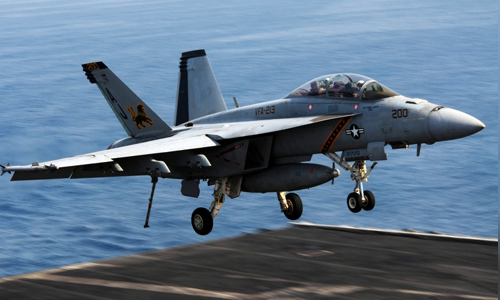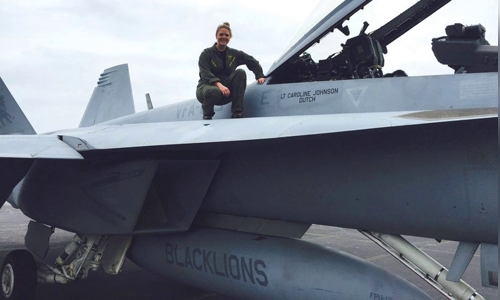Caroline Johnson, a weapons officer on the F / A-18F fighter, said she had "no time to be scared" when on combat duty in the Middle East.
"You have to concentrate so much that there is no time left to fear or think that you might be shot down while on combat duty," said Caronline Johnson, a former female officer driving a weapon on an F / A fighter. -18F Super Hornet, recalled in an December 17 interview.

VFA-213 fighters landed on aircraft carriers in Arab Bay in 2014 Photo: US Navy
Johnson served in the 213 Fighter Squadron (VFA-213), appearing in 42 combat missions in Afghanistan, Iraq and Syria in 2014. She was one of the first female pilots to participate in the campaign. proclaimed the Islamic State (IS) rebels in Iraq as a target and weapons deployment.
After graduating from the US Naval Academy in 2009, Johnson began his pilot training course at Pensacola Naval Air Base in Florida. She always achieved good academic performance, leading the course in many training faculties.
Two years later, Johnson wants to become a Super Hornet fighter pilot. One of Pensacola's teachers guided her this way.
In early 2014, Captain Johnson was drafted to VFA-213 and left Norfolk Port on the aircraft carrier USS George H.W. Bush. Her mission and her companions' mission was to support the Taliban rebel operation in Afghanistan, but it was converted into a battle against ISIS only a few months later.
Johnson and his teammates initially only scouted and gathered intelligence data, which led her to witness many of the IS crimes on the ground. US President Barack Obama allowed US troops to attack IS two months later. The first air strike took place on August 8, 2014, making Johnson yearn to be the first woman to attack the terrorist force.
Just a few hours later, her wish came true. From the back seat of the F / A-18F, Johnson dropped two laser guided GBU-54 bombs on two IS armored vehicles. The next target was a reinforced Humvee armored vehicle and a rocket launcher, which was quickly destroyed by a Maverick surface-to-air missile.

Johnson on his F / A-18F painted her name Photo: Jet Girls
"We cannot stop, we must maintain the fight to protect the lives of those who are threatened by IS," Johnson said. She destroyed a total of 16 IS rebels and accumulated 250 flight hours.
"The combat mission poses more physical and mental challenges than I imagined. You never thought sitting in a cockpit would be exhausting, but it was one of the most painful and painful experiences. and most can happen to one person, "Johnson said.
Female pilots also face gender discrimination when serving in VFA-213. About 18% of the active duty of the US Navy is female, but this figure is only 1.7% of the Navy Air Force fighter pilot community.
Johnson suffered from depression after the campaign in the Middle East and wanted to find a new direction because of feeling isolated from his teammates, before leaving the fighting force and returning to the Naval Academy. This was one of the most difficult decisions in Johnson's life, when she had to give up F / A-18 fighters and switch to training students. Very few US Navy fighter pilots choose this direction.
"It was heartbreaking, I know a chapter ended in my pilot career. However, being a flight instructor and flight commander at the place where trained me was the best experience," Johnson said.



 KhaingNyeinThant
KhaingNyeinThant







